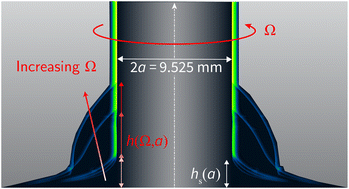Rod-climbing rheometry revisited
Abstract
The rod-climbing or “Weissenberg” effect in which the free surface of a complex fluid climbs a thin rotating rod is a popular and convincing experiment demonstrating the existence of elasticity in polymeric fluids. The interface shape and steady-state climbing height depend on the rotation rate, fluid elasticity (through the presence of normal stresses), surface tension, and inertia. By solving the equations of motion in the low rotation rate limit for a second-order fluid, a mathematical relationship between the interface deflection and the fluid material functions, specifically the first and second normal stress differences, emerges. This relationship has been used in the past to measure the climbing constant, a combination of the first (Ψ1,0) and second (Ψ2,0) normal stress difference coefficients from experimental observations of rod-climbing in the low shear rate limit. However, a quantitative reconciliation of such observations with the capabilities of modern-day torsional rheometers is lacking. To this end, we combine rod-climbing experiments with both small amplitude oscillatory shear (SAOS) flow measurements and steady shear measurements of the first normal stress difference from commercial rheometers to quantify the values of both Ψ1,0 and Ψ2,0 for a series of polymer solutions. Furthermore, by retaining the oft-neglected inertial terms, we show that the “climbing constant” ![[small beta, Greek, circumflex]](https://www.rsc.org/images/entities/i_char_e114.gif) = 0.5Ψ1,0 + 2Ψ2,0 can be measured even when the fluids, in fact, experience rod descending. A climbing condition derived by considering the competition between elasticity and inertial effects accurately predicts whether a fluid will undergo rod-climbing or rod-descending. Our results suggest a more general description, “rotating rod rheometry” instead of “rod-climbing rheometry”, to be more apt and less restrictive. The analysis and observations presented in this study establish rotating rod rheometry combined with SAOS measurements as a prime candidate for measuring normal stress differences in complex fluids at low shear rates that are often below commercial rheometers' sensitivity limits.
= 0.5Ψ1,0 + 2Ψ2,0 can be measured even when the fluids, in fact, experience rod descending. A climbing condition derived by considering the competition between elasticity and inertial effects accurately predicts whether a fluid will undergo rod-climbing or rod-descending. Our results suggest a more general description, “rotating rod rheometry” instead of “rod-climbing rheometry”, to be more apt and less restrictive. The analysis and observations presented in this study establish rotating rod rheometry combined with SAOS measurements as a prime candidate for measuring normal stress differences in complex fluids at low shear rates that are often below commercial rheometers' sensitivity limits.



 Please wait while we load your content...
Please wait while we load your content...